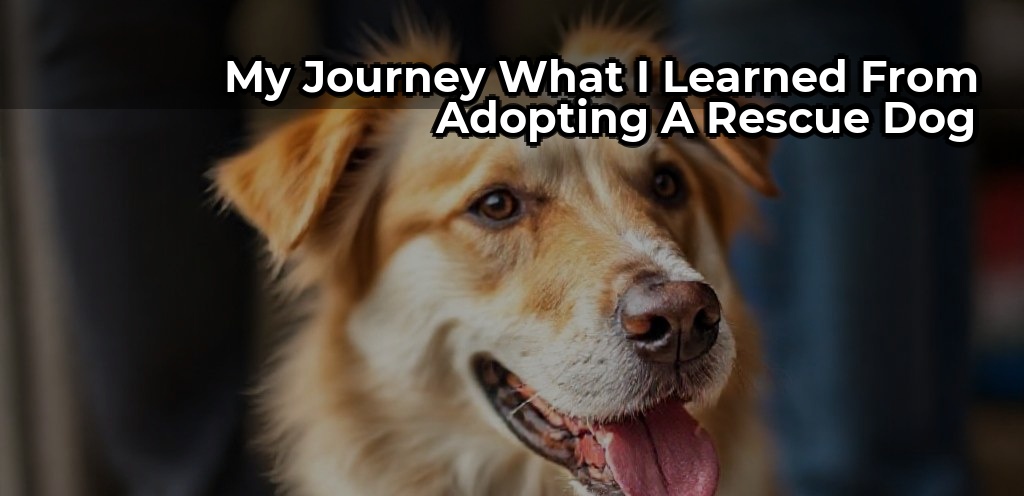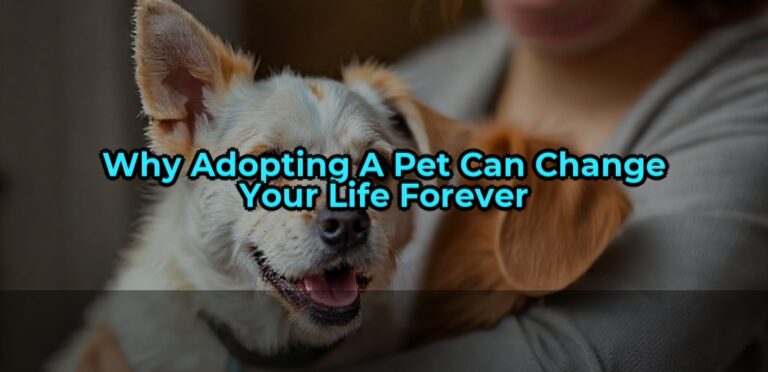My Journey: What I Learned From Adopting a Rescue Dog
It all started with a stray I encountered not far from my house. A scruffy, trembling little thing, eyes full of uncertainty—yet somehow holding onto a flicker of hope. I still remember that moment vividly. I’d always wanted a dog, but I never expected that a chance encounter like this would reshape my entire perspective on loyalty, trust, and patience. That day was the beginning of what turned into a wild, eye-opening ride—my journey with adopting-a-pet-can-change-your-life-forever/” title=”Why Adopting a Pet Can Change Your Life Forever”>adopting and caring for a rescue dog.
From Stranger to Family: The Decision to Rescue
Recognizing the Signs
My first hurdle was understanding just how much was involved. I’d read all about rescue stories online, but nothing quite prepared me for the real deal. Those nervous glances, trembling paws, and the way she cowered in corners. She wasn’t just street-smart; she was scared out of her mind. I knew right then that this wasn’t going to be a quick fix. Rescue dogs come with stories—trauma, mistrust, a whiff of uncertainty—and it’s your job to decode what’s beneath the surface.
Why I Chose to Adopt
- Saving a life: It’s a simple motivation, but when you see a dog abandoned or neglected, the guilt and frustration hit hard. It’s a tangible way to make a difference.
- Rehoming a deserving soul: Rescue animals often have a slew of health issues or behavioral quirks, but they bring unfiltered love—more genuine than some pedigrees.
- Breaking the cycle: My decision was also driven by a desire to challenge stereotypes. Rescues are just as capable of being loyal and brilliant companions as any purebred.
The First Weeks: Facing Reality and Building Trust
Understanding Her Past
My first lesson was dealing with her past. It was obvious that trust was fragile. She flinched at sudden noises, shied away from hands reaching out, and took ages to eat her food. I quickly learned that patience isn’t just a virtue—it’s the foundation for healing in rescue work.
Each day, I spent hours just sitting on the floor, speaking softly, letting her come to me on her terms. No forcing, no rushing. It’s a game of incremental progress. If I tried to rush things, she’d shut down completely. I had to rebuild that fragile thread of trust piece by piece.
Implementing Practical Strategies
- Routine matters: I fixed consistent feeding times, walks, and quiet time. Predictability gives a rescue dog a sense of safety.
- Positive reinforcement: Every small step forward was rewarded—soft words, treats, gentle petting. This helped her associate humans with kindness rather than danger.
- Safe space: I created a little corner with her bed, toys, and blankets. It became her sanctuary; a space she owns.
Mindset Shifts and Unexpected Challenges
Expecting the Unexpected
Nothing prepared me for the rollercoaster. Some days, she’d thrive—playing, wagging her tail, eager for walks. Other days, she’d hide, refuse to eat, or lash out out of fear. I realized early on that rescue is not a linear journey. There’s no “one size fits all,” only consistent effort and understanding.
Myths Busted
- Rescue dogs are damaged beyond repair: Absolutely false. Most just need time, patience, and love. I saw her recover personal pieces of herself gradually—showing signs of joy, curiosity, even mischief.
- Dogs with trauma won’t bond: Again, wrong. Connection depends on your approach. The key is patience and persistence.
Tools I Found Invaluable
Training Techniques That Actually Work
I relied heavily on clicker training—consistent, gentle, positive. It quickly became a game changer for behavioral issues like leash pulling or separation anxiety. Pairing a click sound with treats encourages her to associate commands with good outcomes, fostering cooperation without fear.
Community Support and Resources
- Local rescue groups: Their advice, regular check-ins, and emotional support kept me going.
- Vet partnerships: Regular health assessments, vaccinations, and behavioral advice helped track her progress and catch issues early.
- Online forums: Sharing highs and lows with other adopters opened my eyes to techniques and stories that reassured me I was on the right path.
Personal Growth Through the Experience
Patience as a Virtue
Before adopting, I’d thought of myself as a fairly patient person. Turns out, nothing compares to the patience needed for a traumatized animal. I learned that progress is often invisible, but steady. Sometimes, I’d sit there for hours, just observing her subtle shifts—those tiny glimmers of trust meant everything to me.
Empathy and Emotional Depth
Watching her struggle with basic routines made me reflect on resilience. Every small victory, like a wagging tail or a gentle lick, felt like a personal triumph. I found myself more attuned to her emotions—and, honestly, more compassionate in general. It’s a deeper kind of understanding that transcends words.
What I’d Tell Someone Considering Rescue
Be Prepared for a Long Haul
It’s a marathon, not a sprint. Set your expectations accordingly. The process can be exhausting, but the rewards are often game-changing.
Don’t Rush the Process
Every dog is on their own timetable. Pushing them before they’re ready can set everything back. Patience, again, is your best ally.
Trust the Dog’s Cues
They communicate differently than humans. Pay attention to their body language—ears, tail, posture—that’s how they talk without words.
Be Ready for Emotional Moments
Some days, she’d hide or be aggressive; other days, she’d trust and seek cuddles. I learned to accept those ups and downs without overreacting or losing hope.
Turning Point: The First Signs of True Bond
When She Started Coming to Me
The moment she approached me, tail wagging, with a slight lick, I knew I’d crossed a threshold. It wasn’t about fixing her anymore; it was about partnership. That’s when I realized this journey was worth every sleepless night, every patience-testing moment, every tear of frustration. It was about building a relationship—an honest, raw connection.
Not Just a Rescue, but a Lesson
This experience taught me more about trust, vulnerability, and perseverance than any book or lecture ever could. It showed me that healing takes time and that sometimes, the smallest steps are the biggest wins.
That first hesitant approach was a pivotal moment. It shattered some of the fog of uncertainty that had clouded our interactions for weeks. From that point, small but meaningful breakthroughs began to ripple through our days—her coming out of her shell, trusting me enough to take treats from my hand, and even curling up beside me during quiet evenings. Leading up to that, I realized that patience and consistency weren’t just tools—they are the pillars of building a bond with a rescue dog. But beyond that, I started recognizing certain patterns in her behavior that revealed deeper truths about her past and her capacity for healing. Understanding what triggers her anxiety became a critical part of our progress. Schedule disruptions, loud noises, or new people could set her off, but over time, I learned to anticipate these moments and prepare her. Carrying treats, offering a comforting voice, or subtly redirecting her attention often diffused potential crises. It’s almost like a dance—there’s rhythm, sensitivity, and knowing when to step back or lean in. And the more I did it, the more confident I became that healing isn’t linear. Sometimes, she’d have a good day where she’d explore new spaces, and the next, she’d retreat into her shell. That’s okay. Flexibility matters more than rigid expectations. As our connection grew, I uncovered how crucial boundaries are, not just for her sake, but for mine too. In early days, I’d unknowingly push her too fast or try to make her do things she wasn’t ready for—like introducing her to loud social environments or forcing eye contact. That often led to setbacks, and I had to learn to read her signals better. Now, I respect her pace, giving her control over interactions. When she sniffs at a new person but doesn’t approach or lunges nervously when a doorbell rings, I see those cues as invitations or warnings. Respecting her boundaries doesn’t mean I’m giving in; it signals trust. And trust, once established, becomes the foundation of lasting partnership. Case studies from my own experience—and those I’ve read about—highlight similar patterns. Dogs who come from abusive or neglectful backgrounds often carry invisible scars. They might hide when overwhelmed, freeze in fear, or lash out defensively. In each scenario, patience and understanding are the defaults. One rescue I connected with online, Bella—a terrier mix—had severe separation anxiety. Her owner used gradual desensitization: first, leaving her for just a few seconds, then gradually extending those periods while providing engaging toys and treats. Over weeks, Bella learned that absence isn’t abandonment. It’s a method I adopted with my own dog, meticulously extending our alone time while making it a positive experience. What truly moved me was witnessing her small victories—a wagging tail after hearing my footsteps, confident walks without trembling, a tail tucked in retreat now flicking upwards. Each moment reinforced that trust grows in tiny increments, not giant leaps. That’s a principle I wish someone had emphasized more before I started—patience isn’t just virtue; it’s strategy. Knowing when to push for progress and when to hold back takes practice, but it pays off exponentially. Another key insight? Environmental stability makes a world of difference. My home became her sanctuary—predictable, calm, and safe. I avoided sudden loud noises, used calming scents like lavender, and kept routines consistent. This created a ripple effect: her anxiety levels dropped, and she started seeking out comfort in familiar spaces. Little things like keeping her bed in a quiet corner or providing a soft blanket became grounding anchors for her. Sometimes, I’d catch her nestled in her bed, eyes half-closed, like she was able to fully relax for the first time. That’s when I realized how much non-verbal communication matters. Dogs don’t speak our language, but they present their feelings openly if you learn to read them. I paid close attention not only to her body language but also to subtle shifts in mood. Ears pinning back, tail tucked low, or avoiding eye contact often signaled her discomfort. Conversely, leaning into me or seeking eye contact was her way of saying, “I trust you.” The more I tuned in, the more our communication deepened. It became a shared language—an unspoken promise that I’d respect her needs and boundaries. The most profound learning, perhaps, was that healing is a marathon, not a sprint. I used to think progress meant big moments—like her eagerly fetching a ball or cuddling on my lap. While those moments are sweet, they’re the frosting. The real work is in the small, everyday acts—offering gentle reassurance when she fears thunder, praising her quietly after a successful social walk, or simply sitting with her in silence. It’s the ongoing devotion to showing up, consistent and patient, that rebuilds trust brick by brick. Every rescue story is different—each dog, their own mosaic of past pain and resilient hope. I’ve learned to embrace their individuality, recognizing that what worked for one might not work for another. For example, I met a couple who adopted a rescue with severe leash reactivity. They discovered that counter-conditioning and controlled exposure in a safe environment dramatically reduced her stress. Conversely, another friend’s dog responded better to scent-based games—finding hidden treats boosted her confidence and decreased her fear of unfamiliar areas. These case studies remind us that adaptability is essential. No single formula exists for building a rescue dog’s trust; instead, it’s a personalized journey. Listening to expert advice, observing your dog’s unique cues, and remaining flexible are what foster genuine growth. And don’t forget, self-awareness plays a role too. Recognize your limits—sometimes, seeking guidance from a behaviorist or trainer can multiply your impact. You’re not alone in this process; professional insight can cut through frustration and provide targeted strategies. This journey profoundly changed how I view not only dogs but patience itself. Every moment of doubt, every setback, became an opportunity to learn and adapt. When I look at how far my dog has come, I see a mirror of resilience—proof that love, patience, and understanding can turn even the most wary soul into a trusted companion. That trust isn’t built overnight, but if you stay committed, it’s a gift that lasts a lifetime.
Final Thoughts
Adopting a rescue dog isn’t a quick fix or a simple endeavor—it’s a partnership rooted in patience, empathy, and a willingness to grow together. Every small victory, from a wagging tail to a wagging heart, reminds us that healing is possible, even from the deepest scars. The lessons I’ve learned from my own journey aren’t just about dogs; they’re about resilience, hope, and the power of consistent love. If you’re considering adopting or already on this path, remember: your ongoing commitment is the most powerful gift you can give. The road may be long, but the rewards are worth every step.


